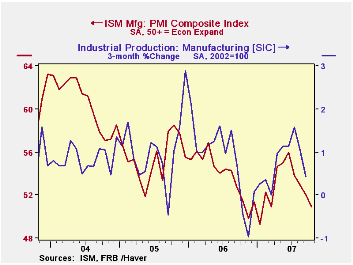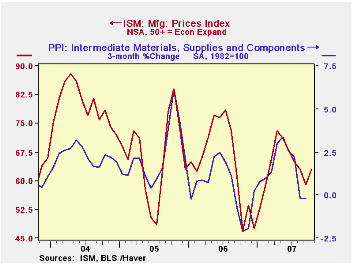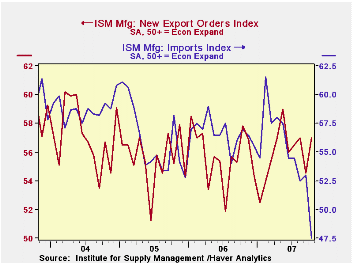 Global| Nov 01 2007
Global| Nov 01 2007ISM Index Near "No Growth" Level
by:Tom Moeller
|in:Economy in Brief
Summary
The Composite Index of activity in the manufacturing sector, reported by the Institute of Supply Management (ISM), fell to 50.9 last month from 52.0 during September. A reading above 50 indicates growth in factory sector activity. [...]

The Composite Index of activity in the manufacturing sector, reported by the Institute of Supply Management (ISM), fell to 50.9 last month from 52.0 during September. A reading above 50 indicates growth in factory sector activity. Consensus expectations had been for a reading of 51.6.
Last month's PMI figure was the lowest since January when industrial production in the factory sector fell 0.6%. The three month % change in factory sector output fell to 0.4% last month
During the last twenty years there has been a 64% correlation between the level of the Composite Index and the three month growth in factory sector industrial production.
It is appropriate to correlate the ISM index level with factory sector growth because the ISM index is a diffusion index. It measures growth by being constructed using all of the absolute positive changes in activity added to one half of the no change in activity measures.
Declines in three of the index's five components accounted for the lower composite index, notable was the decline in the production component. The inventories component rose sharply to its highest level since July and employment also rose.
The modest 0.3 point rise in the employment index to 52.0 followed a 0.4 point September rise. During the last twenty years there has been a 67% correlation between the level of the ISM employment Index and the three month growth in factory sector employment.
The index of new export orders recovered all of its September decline with a 2.5 point rise to 57.0. The import index conversely fell to 47.5, the lowest level since 2001 and suggestive that imports declined last month.
The prices index moved much higher with the rise in oil
prices. During the last twenty years there has been a 77% correlation
between the price index and the three month change in the PPI for
intermediate goods.


| October | September | October'06 | 2006 | 2005 | 2004 | |
|---|---|---|---|---|---|---|
| Composite Index | 50.9 | 52.0 | 51.5 | 53.9 | 55.5 | 60.5 |
| New Orders Index | 52.5 | 53.4 | 52.1 | 55.4 | 57.4 | 63.5 |
| Prices Paid Index (NSA) | 63.0 | 59.0 | 47.0 | 65.0 | 66.4 | 79.8 |
Tom Moeller
AuthorMore in Author Profile »Prior to joining Haver Analytics in 2000, Mr. Moeller worked as the Economist at Chancellor Capital Management from 1985 to 1999. There, he developed comprehensive economic forecasts and interpreted economic data for equity and fixed income portfolio managers. Also at Chancellor, Mr. Moeller worked as an equity analyst and was responsible for researching and rating companies in the economically sensitive automobile and housing industries for investment in Chancellor’s equity portfolio. Prior to joining Chancellor, Mr. Moeller was an Economist at Citibank from 1979 to 1984. He also analyzed pricing behavior in the metals industry for the Council on Wage and Price Stability in Washington, D.C. In 1999, Mr. Moeller received the award for most accurate forecast from the Forecasters' Club of New York. From 1990 to 1992 he was President of the New York Association for Business Economists. Mr. Moeller earned an M.B.A. in Finance from Fordham University, where he graduated in 1987. He holds a Bachelor of Arts in Economics from George Washington University.






